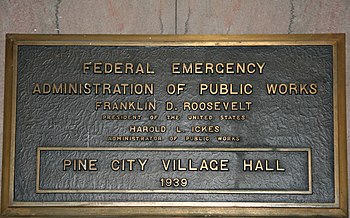
Back إدارة الأشغال العامة Arabic Public Works Administration Danish Public Works Administration German Public Works Administration Spanish Yhdysvaltain julkisten töiden hallinto Finnish Public Works Administration French Public Works Administration Italian Public Works Administration Dutch Администрация общественных работ Russian Public works administration SIMPLE


The Public Works Administration (PWA), part of the New Deal of 1933, was a large-scale public works construction agency in the United States headed by Secretary of the Interior Harold L. Ickes. It was created by the National Industrial Recovery Act in June 1933 in response to the Great Depression. It built large-scale public works such as dams, bridges, hospitals, and schools. Its goals were to spend $3.3 billion (about $10 per person in the U.S.) in the first year, and $6 billion (about $18 per person in the U.S.) in all, to supply employment, stabilize buying power, and help revive the economy. Most of the spending came in two waves, one in 1933–1935 and another in 1938. Originally called the Federal Emergency Administration of Public Works, it was renamed the Public Works Administration in 1935 and shut down in 1944.[1]
The PWA spent over $7 billion (about $22 per person in the U.S.) on contracts with private construction firms that did the actual work. It created an infrastructure that generated national and local pride in the 1930s and is still vital nine decades later. The PWA was much less controversial than its rival agency, the Works Progress Administration (WPA), headed by Harry Hopkins, which focused on smaller projects and hired unemployed unskilled workers.[2]
- ^ "Records of the Public Works Administration". National Archives. August 15, 2016.
- ^ Smith, Jason Scott (2006). Building New Deal Liberalism: The Political Economy of Public Works, 1933–1956. Cambridge University Press. ISBN 9780521139939.